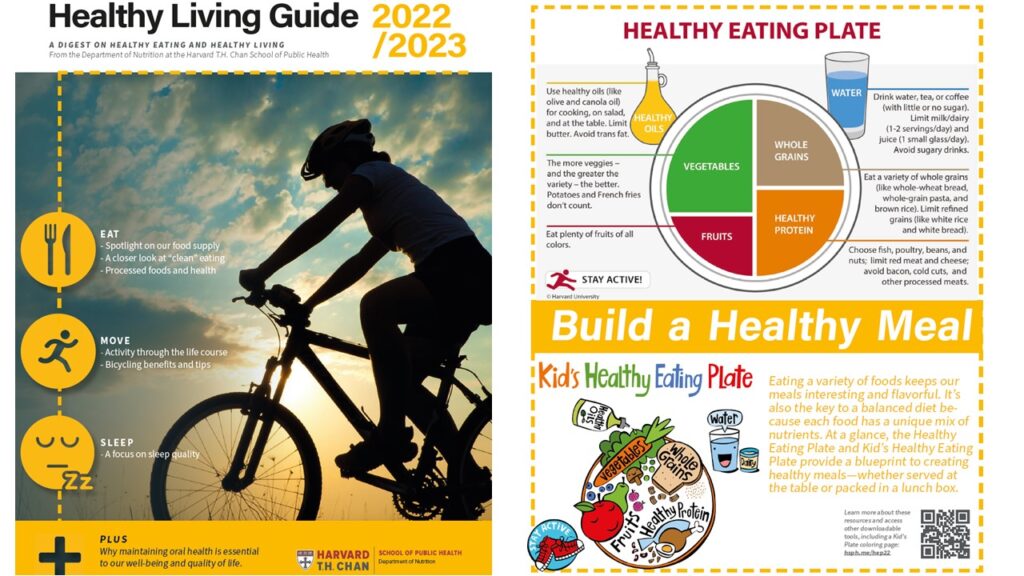The experts at Harvard T.H. Chan’s School of Public Health’s latest guide to healthy living. This comprehensive guide on what to eat, type of exercise, amount of sleep and much more is a valuable resource. The guide is easy to read and includes healthy eating plates, printable tips and summaries.

The experts at Harvard T.H. Chan’s School of Public Health’s latest guide to healthy living, this comprehensive guide on what to eat, type of exercise, amount of sleep and much more is a valuable resource. For those of us short on time, our highlights of the 32-page guide are provided below.
A blueprint for building healthy meals
Healthy Eating Plate: 1/2 – vegetables and fruits, 1/4 – whole grains, 1/4 – protein. Use healthy plant oils in moderation, drink water/coffee/tea, and stay active.
The main message of the Healthy Eating Plate is to focus on diet quality. The type of carbohydrate in the diet is more important than the amount of carbohydrate in the diet. The Healthy Eating Plate also advises us to avoid sugary beverages and encourage us to use healthy oils, and it does not set a maximum on the percentage of calories people should get each day from healthy sources of fat.
Five factors for a longer and healthier lifespan
- Healthy diet – The prevalence of hypertension (high blood pressure) and dementia increases with age. A healthy diet can lower the risk of these and other chronic conditions that accompany older ages.
- Regular exercise – Regular physical activity lowers the risk of several chronic conditions that increase with age including heart disease, hypertension, diabetes, osteoporosis, certain cancers, and cognitive decline. Exercise also helps to lower anxiety and blood pressure, and improve sleep quality.
- Healthy weight – Determining one’s healthy weight range is unique for each person. Rather than focusing on scale weight alone, monitoring an increase in harmful visceral “belly fat” and weight change since age 20 may be useful.
- Not smoking -Smoking is a strong risk factor for cancer, diabetes, cardiovascular disease, lung diseases, and earlier death as it promotes chronic inflammation and oxidative stress (a condition that can damage cells and tissues).
- Moderate alcohol – Research finds that moderate drinking, defined as 1 drink daily for women and 2 drinks daily for men, is associated with lower risk of type 2 diabetes, heart attacks, and early death from cardiovascular disease.
Processed foods and health
Processed foods may bring to mind a packaged food item containing many ingredients, perhaps even artificial colors, flavors, or other chemical additives. Often referred to as convenience or pre-prepared foods, processed foods are suggested to be a contributor to the obesity epidemic and rising prevalence of chronic diseases like heart disease and diabetes. Food processing is a spectrum that ranges from basic technologies like freezing or milling, to the incorporation of additives that promote shelf stability or increase palatability. As a general rule, emphasizing unprocessed or minimally processed foods in the daily diet is optimal. If you are deciding whether or not to include a highly processed food in your diet, it may be useful to evaluate its nutritional content and long-term effect on health. An ultra-processed food that contains an unevenly high ratio of calories to nutrients may be considered unhealthy.
The science of snacking
A snack is generally defined as any food eaten between main meals. A snack portion should be enough to satisfy but not so much that it interferes with your appetite for a meal or adds too many calories. Research has attempted to see if snacking has a positive or negative impact on nutrition and health outcomes—but without a clear answer. A general rule of thumb is to aim for about 150-250 calories per snack.
The importance of oral health
The health of our mouth, or oral health, is more important than many of us may realize. It is a key indicator of overall health, which is essential to our well-being and quality of life. In a healthy mouth, tissues are moist, odor-free, and pain-free. Just like a healthy body, a healthy smile depends on good nutrition. A balanced diet with adequate nutrients is essential for a healthy mouth and in turn, a healthy mouth supports nutritional well-being. Water is the clear winner as the best drink for your teeth—particularly fluoridated water.
Staying active
Research strongly supports its benefits across a range of physical and mental health conditions for people of all ages. All types of exercises offer health benefits. Performing different types of exercises can expand the range of benefits even further. But it is important to remember that some exercise is better than none, and that most everyone can participate in some form of exercise safely.
Updates on sleep
Sleep plays a critical role in brain as well as physical functioning. About one-third of American adults do not get enough sleep each night, according to the Centers for Disease Control and Prevention. Short sleep duration in adults is defined as less than 7 hours of sleep in 24 hours. In children, insufficient sleep can lead to attention and behavior problems or hyperactivity. Sleep needs change as we age, with the average person generally requiring less sleep at older ages. However, specific sleep amounts vary by individual.
Test your healthy living knowledge
Helpful Resources
A healthy plate – Asian diet provided by Kaiser Permanente, one of America’s leading health care providers and not-for-profit health plans founded in 1945.
Healthy eating plate for any cuisine provided by Kaiser Permanente.
Get a monthly dose of our latest insights!


About
myasianvoice
At MyAsianVoice, we connect Asian Americans to surveys and research to bridge the Asian data gap.
Join our growing respondent list >>
